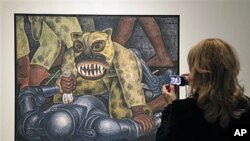In 1931, the fledgling Museum of Modern Art chose Mexican muralist Diego Rivera for its second major show, inviting him to New York to create “portable” murals onsite. Now, some of the works he created in six feverish weeks are again on display at MoMA.
They are aggressive and vibrant, testimony to Rivera’s fascination with Mexican history and his loathing of capitalism.
A communist, Rivera created fiercely political works picturing Mexico’s colonial past and the struggles of indigenous peoples. Indian Warrior, for example, illustrates his anger at Spain’s conquest of Mexico in the 1600s. An Aztec warrior wearing a fearsome Jaguar costume uses a stone knife to cut down a conquistador who lies dead, still encased in his armor.
Rivera also painted scenes of what he saw as capitalist oppression in the U.S. and the struggle for workers' rights in a rapidly industrializing America.
“He made pictures that made us think about what our society is like, about labor and class, and the inequities of our modern world,” MoMA curator Leah Dickerman said. She points to the mural, Frozen Assets, a depiction of New York City, in 1931, in the depths of the Great Depression. The mural has several tiers, with New York’s new skyscrapers towering above what looks like a subterranean morgue.
“In the top tier of the painting, you see all the most recent landmarks of modern architecture,” Dickerman says. “Under that, you see the shelter for unemployed men that was on East 25th Street. Then under that, you see a bank vault where the city’s richest citizens are waiting to count their assets.”
Rivera was already famous when he and his wife, artist Frida Kahlo, arrived in New York for the MoMA commission. Born in 1886, Rivera had studied painting in Europe in the early 1900s.
There he developed, then abandoned, an interest in Cubism in favor of realistic frescoes - paintings on wet plaster - focusing on Mexico's revolution. At the time, murals were Mexico's leading public art form.
The show also includes watercolors from a visit to Moscow in 1927-1928, where Rivera celebrated the tenth anniversary of the Soviet revolution.
Visitors have packed the show since its opening in November. Art historian Anna Indych-Lopez said that’s because Rivera’s message remains relevant.
“This work speaks to people today for obvious reasons,” she said. “If we just open up the newspaper and look at the events surrounding Occupy Wall Street, these are issues that have not gone away."
“What he was showing, really, was his interest in the uprising of the common people,” says visitor Lenore Zarin. Paula Santos, also visiting the show, said as a Mexican American, she was touched by Rivera’s dedication to “people you don’t usually see, indigenous people.” “It was really poignant for me," she said, "that even today, he could have painted those frescoes.”
The MoMA show also includes a sketch for one of Rivera’s most famous works, although few people ever saw it.
Man at the Crossroads was the title of the work commissioned in 1933 by New York’s Rockefeller family, for one of its Rockefeller Center buildings. It was supposed to illustrate the progress of “civilization” on a grand scale. But a controversy erupted in the press over Rivera’s insertion of a small portrait of Lenin. The artist refused the Rockefellers' request to remove it, and he was dismissed. The mural was covered up and later destroyed.
Indych-Lopez, an expert on Rivera, said the artist's radical politics, typical among Mexican artists of the time, was indulged by his patrons, including MoMA founder Abby Aldrich Rockefeller.
Indych-Lopez said the management of Rockefeller Center, charged with leasing office space in the building, strongly objected.
“They believed they had to make a public stand against this very overt visualization of communism, the fact that this was a public gesture that would have faced workers entering into the heart of capitalism day in and day out,” she said.
Dickerman and Indych-Lopez also cite reports that the Rockefellers were offended by the inclusion of a portrait that appeared to be the teetotaling patriarch, John D. Rockefeller, holding a drink, during the period of prohibition.
In the ensuing furor, Rivera lost a commission to paint at the World’s Fair in Chicago. Undaunted, he returned to Mexico City and created an almost identical mural for the Palacio De Bellas Artes.
The show at MoMA is on view until mid-May 2012.







